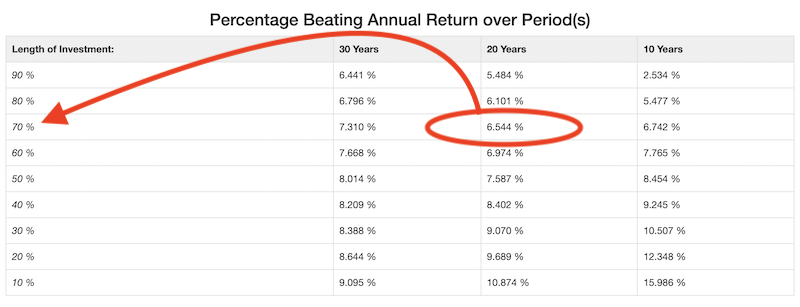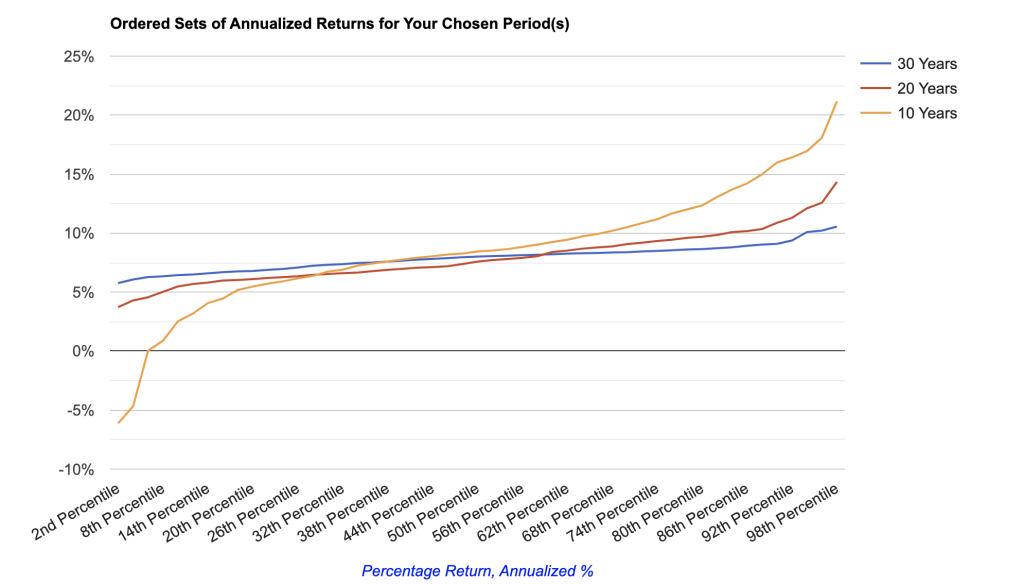Here’s a NASDAQ Historic Interval Return Calculator. Discover the historic efficiency of the NASDAQ Composite Index over customized time intervals, analyzing rolling returns, volatility, and extra.
Up to date via the newest market shut. For final yr’s efficiency, see the 2023 NASDAQ Return.
NASDAQ Historic Interval Return Calculator
Enter your required funding size(s) to investigate the NASDAQ Composite Index’s historic efficiency over rolling intervals of that size. You can too regulate for inflation and reinvestment of dividends to see a extra correct reflection of whole returns.
- Regulate for Inflation (CPI)? – Select whether or not to regulate the returns for inflation to replicate actual buying energy adjustments over the funding interval.
- Reinvest Dividends – Resolve if you wish to calculate the expansion of your funding with dividends reinvested again into the index.
- + Add Extra Durations – By default, the software has three funding lengths enter – 10, 20, and 30 years. So as to add extra intervals to your funding, click on the button.
- – Take away – You probably have too many intervals in your evaluation, take away a interval from the evaluation with the Take away button.
If you’re completely satisfied together with your inputs, hit the Calculate Historic Returns button to begin the evaluation.
NASDAQ Rolling Interval Evaluation Outputs
If you begin the evaluation, the software will output returns for the rolling intervals you chose:
- Utilizing (CPI) Inflation Adjustment – Whether or not the rolling interval outcomes are adjusted for inflation.
- Calculating Dividend Reinvestment – Whether or not the rolling interval outcomes are adjusted for inflation.
- Month-to-month Realized Historic Volatility – For month over month intervals, we’ve got calculated the historic volatility. (See right here for a proof.)
- Annual Realized Historic Volatility – The identical calculation for yr over yr outcomes.
- Abstract Statistics – Common, median, most and minimal return in addition to the commonplace deviation of returns for your entire chosen intervals.
Percentile Desk
For each interval you chose, the software computes the proportion of intervals that beat a selected return. You will discover this within the Outcomes for Interval(s) tab. The return is overwhelmed by the proportion of rolling intervals within the far left column.
Here is an instance of an interpretation:


Within the above screenshot, I’ve highlighted 6.544% within the 20 Years column. Tracing the row, i see the 70% label. Meaning, for my run (and the information within the software and historical past to that time):
70% of all 20 yr rolling intervals within the information so far returned 6.544% a yr or extra.
Interval and Percentile Graph
Within the Chart for Interval(s) tab, you will discover a graph of rolling interval historic returns. There will probably be a separate line for every interval size you select.
Within the following screenshot, for my run (and the information as much as that time), the software graphed rolling 10, 20, and 30 yr returns.


On the Y-Axis are annualized returns. On the X-Axis are the percentile of intervals. To interpret this, at any level on the road, “100% minus that percentile” of returns beat it.
In my evaluation, I can hover over the ten yr line for the fiftieth Percentile (the Median). For my instance, it was 8.454%. I can interpret that to imply 100-50 = 50% of intervals within the set beat that return (or tied). And sure, 50% of intervals returned much less yearly.
Methodology for the NASDAQ Historic Return Calculator
The information for this calculator is sourced NASDAQ data and adjusted utilizing CPI information from the U.S. Bureau of Labor Statistics to account for inflation. Dividend info is backed into and estimated – learn the NASDAQ Return Calculator‘s Methodology part for extra info.
There are some caveats to the outcomes:
- ‘Month’ is a median – The software makes use of month-to-month common closing costs for the NASDAQ, offering a smoothed estimate of efficiency. For instance, for any random month within the dataset, the information level is the common closing worth.
- Charges should not included – The calculator doesn’t account for administration charges, transaction charges, slippage, or different prices related to investing.
- Information protection begins from 1973 – The NASDAQ Composite Index began in 1973, however my evaluation included dividend estimates again to 1973.
- Taxes should not included – The calculator doesn’t consider potential tax liabilities from dividends or capital features.
I’ve additionally constructed an analogous software for the Dow Jones Industrial Common and S&P 500.
Disclaimers for the NASDAQ Historic Return Calculator
This software is meant for informational and analysis functions solely. Whereas we try for accuracy, the information supplied is an estimate and must be verified with further sources. This calculator doesn’t present monetary recommendation or replicate precise funding outcomes. And, importantly for this software, know that historic returns don’t suggest or assure future returns.

